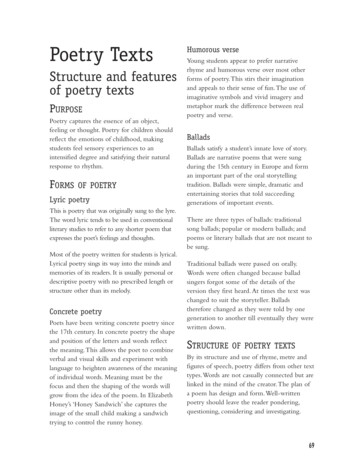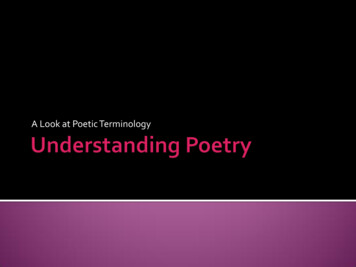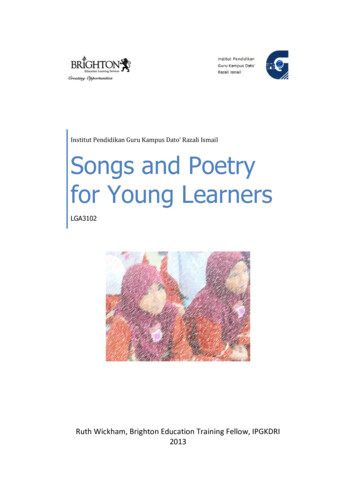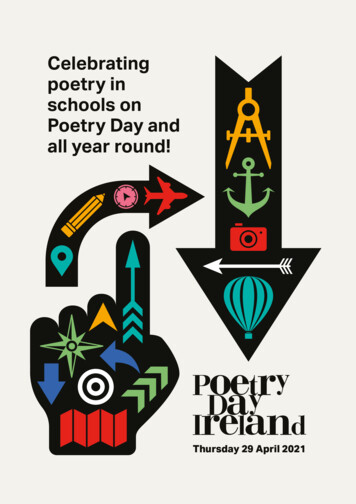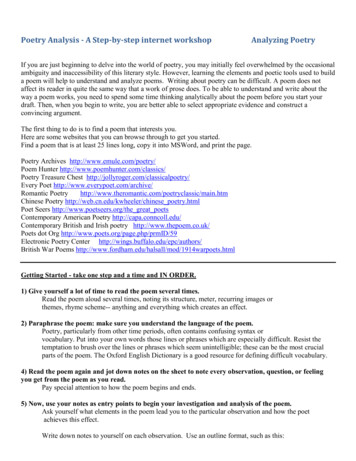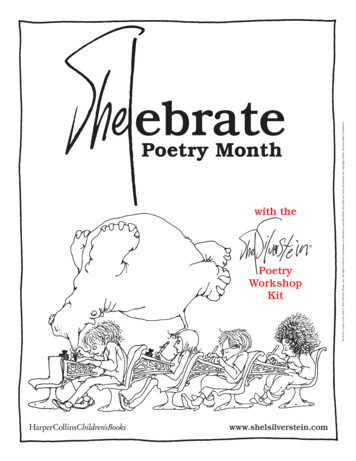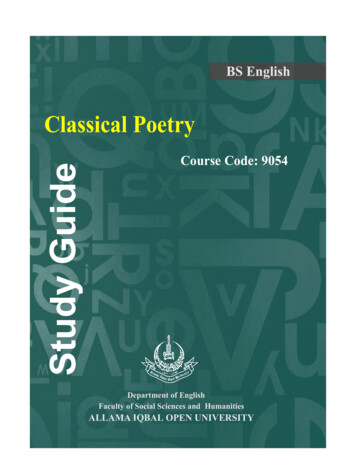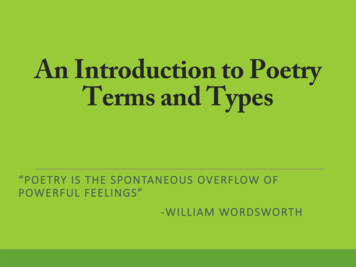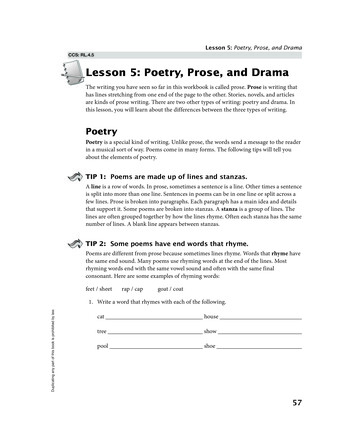
Transcription
Oxford Cambridge and RSAGCSE English LiteratureJ352/02 Exploring poetry and ShakespeareSample Question PaperDate – Morning/AfternoonVersion 2.1Time allowed: 2 hoursYou must have: The Question Paper The OCR 12–page Answer BookletINSTRUCTIONS Use black ink. Answer two questions. One from Section A and one from Section B. All questions in Section A consist of two parts a) and b). Answer both parts of the question onthe poetry cluster you have studied. In Section B, answer one question from a choice of two on the text that you have studied. Write your answers to each question on the Answer Booklet. Write the number of each question answered in the margin. This is a closed text examination. Do not write in the bar codes.INFORMATION The total mark for this paper is 80.The marks for each question are shown in brackets [ ].Quality of extended responses will be assessed in questions marked with an asterisk (*).This document consists of 16 pages. OCR 2020[601/4872/X]J352/02Turn Over
2 OCR 2020Section A – Poetry across timeQuestionPageLove and Relationships13Conflict25Youth and Age37Section B – ShakespeareQuestionPageRomeo and Juliet4/59The Merchant of Venice6/710Macbeth8/911Much Ado About Nothing10/1112J352/02
3Section APoetry across time1Love and RelationshipsRead the two poems below and then answer both part a) and part b).You are advised to spend about 45 minutes on part a) and 30 minutes on part b).a)Compare how the speakers in these poems express feelings of being let down in love.You should consider: ideas and attitudes in each poem tone and atmosphere in each poem the effects of the language and structure used.[20]ANDb)Explore in detail one other poem from your anthology which expresses doubt oruncertainty in relationships.[20]A Broken Appointment by Thomas HardyYou did not come,And marching Time drew on, and wore me numb.Yet less for loss of your dear presence thereThan that I thus found lacking in your make5That high compassion which can overbearReluctance for pure lovingkindness’ sakeGrieved I, when, as the hope-hour stroked its sum,You did not come.You love not me,10And love alone can lend you loyalty;–I know and knew it. But, unto the storeOf human deeds divine in all but name,Was it not worth a little hour or moreTo add yet this: Once you, a woman, came15To soothe a time-torn man; even though it beYou love not me. OCR 2020J352/02Turn over
4The Breather by Billy CollinsJust as in the horror movieswhen someone discovers that the phone callsare coming from inside the houseso too, I realized5that our tender overlappinghas been taking place only inside me.All that sweetness, the love and desire—it’s just been me dialing myselfthen following the ringing to another room10to find no one on the line,well, sometimes a little breathingbut more often than not, nothing.To think that all this time—which would include the boat rides,15the airport embraces, and all the drinks—it’s been only me and the two telephones,the one on the wall in the kitchenand the extension in the darkened guest room upstairs. OCR 2020J352/02
52ConflictRead the two poems below and then answer both part a) and part b).You are advised to spend about 45 minutes on part a) and 30 minutes on part b).Compare how these poems present the effects of war on people’s lives.a)You should consider: ideas and attitudes in each poem tone and atmosphere in each poem the effects of the language and structure used.[20]ANDb)Explore in detail one other poem from your anthology that presents lives transformed byconflict.[20]Anthem For Doomed Youth by Wilfred OwenWhat passing–bells for these who die as cattle?Only the monstrous anger of the guns.Only the stuttering rifles’ rapid rattleCan patter out their hasty orisons.5No mockeries now for them; no prayers nor bells;Nor any voice of mourning save the choirs,The shrill, demented choirs of wailing shells;And bugles calling for them from sad shires.What candles may be held to speed them all?10Not in the hands of boys, but in their eyesShall shine the holy glimmers of good–byes.The pallor of girls’ brows shall be their pall;Their flowers the tenderness of patient minds,And each slow dusk a drawing–down of blinds. OCR 2020J352/02Turn Over
6In Times of Peace by John AgardThat finger – index to be exact –so used to a trigger’s warmthhow will it begin to deal with skinthat threatens only to embrace?5Those feet, so at home in heavy bootsand stepping over bodies –how will they cope with a bubble bathwhen foam is all there is for ambush?And what of hearts in times of peace?10Will war–worn hearts grow sluggishlike Valentine roses wiltingwithout the adrenalin of a bullet’s blood–rush?When the dust of peace has settled on a nation,how will human arms handle the death of weapons?15And what of ears, are ears so tuned to sirensthat the closing of wings causes a tremor?As for eyes, are eyes ready for the soft danceof a butterfly’s bootless invasion? OCR 2020J352/02
73Youth and AgeRead the two poems below and then answer both part a) and part b).You are advised to spend about 45 minutes on part a) and 30 minutes on part b).a)Compare how these poems present the relationship between fathers and sons.You should consider: ideas and attitudes in each poem tone and atmosphere in each poem the effects of the language and structure used.[20]ANDb)Explore in detail one other poem from your anthology that presents a relationshipbetween a parent and a child.[20]Farther by Owen SheersI don’t know if the day after Boxing Day has a namebut it was then we climbed the Skirrid again,choosing the long way round,through the wood, simplified by snow,5along the dry stone wall, its puzzle solved by moss,and out of the trees into that cleft of earthsplit they say by a father’s griefat the loss of his son to man.We stopped there at an altar of rock and rested,10watching the dog shrink over the hill before continuing ourselves,finding the slope steeper than expected.A blade of wind from the eastand the broken stone giving under our feetwith the sound of a crowd sighing.15Half way up and I turned to look at you,your bent head the colour of the rocks,your breath reaching me, short and sharp and solitary,and again I felt the tipping in the scales of us,the intersection of our ages.20The dog returns having caught nothing but his own tongueand you are with me again, so together we climbed to the topand shared the shock of a country unrolled before us,the hedged fields breaking on the edge of Wales.25Pulling a camera from my pocket I placed it on the trig pointand leant my cheek against the stone to find you in its frame,before joining you and waiting for the shutter’s blinkthat would tell me I had caught this: OCR 2020J352/02Turn Over
8the sky rubbed raw over the mountains,us standing on the edge of the world, together against the view30and me reaching for some kind of purchaseor at least a shallow handhold in the thoughtthat with every step apart, I’m another closer to you.Those Winter Sundays by Robert HaydenSundays too my father got up earlyand put his clothes on in the blueblack cold,then with cracked hands that ached5from labor in the weekday weather madebanked fires blaze. No one ever thanked him.I'd wake and hear the cold splintering, breaking.When the rooms were warm, he'd call,and slowly I would rise and dress,10fearing the chronic angers of that house,Speaking indifferently to him,who had driven out the coldand polished my good shoes as well.What did I know, what did I know15of love's austere and lonely offices? OCR 2020J352/02
9Section BShakespeareRomeo and JulietChoose ONE question.You are advised to spend about 45 minutes on this section.EITHER4Explore how Mercutio’s attitude towards Tybalt, and others, influences events in the play. Referto this extract from Act 3 Scene 1 and elsewhere in the play.[40]*In this extract Tybalt and other Capulets approach Benvolio and Mercutio in a public TYBALTMERCUTIOBENVOLIOMERCUTIOBy my head, here comes the Capulets.By my heel, I care not.Follow me close, for I will speak to them.Gentlemen, good den; a word with one of you.And but one word with one of us?Couple it with something; make it a word and a blow.You shall find me apt enough to that, sir, an you will give me occasion.Could you not take some occasion without giving?Mercutio, thou consortest with Romeo.Consort! What, dost thou make us minstrels? An thou make minstrels of us, lookto hear nothing but discords. Here’s my fiddlestick; here’s that shall make youdance. Zounds, consort!We talk here in the public haunt of men;Either withdraw unto some private place,Or reason coldly of your grievances,Or else depart; here all eyes gaze on us.Men’s eyes were made to look, and let them gaze;I will not budge for no man’s pleasure, I.Enter ROMEOTYBALTMERCUTIOWell, peace be with you, sir. Here comes my man.But I’ll be hang’d, sir, if he wear your livery.Marry, go before to field, he’ll be your follower;Your worship in that sense may call him man.OR5How and why do you think Juliet’s relationship with the Nurse changes? Explore at least twomoments from the play to support your ideas.[40]* OCR 2020J352/02Turn Over
10The Merchant of VeniceChoose ONE question.You are advised to spend about 45 minutes on this section.EITHER6Explore the importance of Antonio and Bassanio’s friendship. Refer to this extract from Act 1Scene 1 and elsewhere in the play.[40]*In this extract Antonio and Bassanio are discussing love and money issues.ANTONIOBASSANIOANTONIOBASSANIOWell; tell me now what lady is the sameTo whom you swore a secret pilgrimage,That you to-day promis’d to tell me of?‘Tis not unknown to you, Antonio,How much I have disabled mine estateBy something showing a more swelling portThan my faint means would grant continuance;Nor do I now make moan to be abridg’dFrom such a noble rate; but my chief careIs to come fairly off from the great debtsWherein my time, something too prodigal,Hath left me gag’d. To you, Antonio,I owe the most, in money and in love;And from your love I have a warrantyTo unburden all my plots and purposesHow to get clear of all the debts I owe.I pray you, good Bassanio, let me know it;And if it stand, as you yourself still do,Within the eye of honour, be assur’dMy purse, my person, my extremest meansLie all unlock’d to your occasions.In my school-days, when I had lost one shaft,I shot his fellow of the self-same flightThe self-same way, with more advised watch,To find the other forth; and by adventuring bothI oft found both. I urge this childhood proof,Because what follows is pure innocence.OR7How and why is money so important to Shylock? Explore at least two moments from the play tosupport your ideas.[40]* OCR 2020J352/02
11MacbethChoose ONE question.You are advised to spend about 45 minutes on this section.EITHER8Explore the idea that Macbeth gradually loses control of himself and his relationships. Refer tothis extract from Act 3 Scene 2 and elsewhere in the play.[40]*In this extract Macbeth has left the banquet hall and Lady Macbeth seeks him out in another partof the castle.LADY MACBETHMACBETHLADY MACBETHMACBETHLADY MACBETHMACBETHLADY MACBETHMACBETHGentle my lord, sleek o’er your rugged looks;Be bright and jovial among your guests to-night.So shall I, love; and so, I pray, be you.Let your remembrance apply to Banquo;Present him eminence, both with eye and tongue –Unsafe the while, that weMust lave our honours in these flattering streams,And make our faces vizards to our hearts,Disguising what they are.You must leave this.O, full of scorpions is my mind, dear wife!Thou know’st that Banquo, and his Fleance, lives.But in them nature’s copy’s not eterne.There’s comfort yet; they are assailable.Then be thou jocund. Ere the bat hath flownHis cloister’d flight; ere to black Hecate’s summonsThe shard–borne beetle with his drowsy humsHath rung night’s yawning peal, there shall be doneA deed of dreadful note.What’s to be done?Be innocent of the knowledge, dearest chuck,Till thou applaud the deed.OR9In what ways is Banquo an important character in the play? Explore at least two moments fromthe play to support your ideas.[40]* OCR 2020J352/02Turn Over
12Much Ado About NothingChoose ONE question.You are advised to spend about 45 minutes on this section.EITHER10Explore how Leonato behaves as a father to Hero. Refer to this extract from Act 4 Scene 1 andelsewhere in the play.[40]*In this extract Hero has fainted having heard Claudio’s accusations. Leonato and the othersgather around ODead, I think. Help, uncle!Hero! why, Hero! Uncle! Signor Benedick! Friar!O Fate, take not away thy heavy hand!Death is the fairest cover for her shameThat may be wish’d for.How now, cousin Hero!Have comfort, lady.Dost thou look up?Yea; wherefore should she not?Wherefore! Why, doth not every earthly thingCry shame upon her? Could she here denyThe story that is printed in her blood?Do not live, Hero; do not ope thine eyes;For, did I think thou wouldst not quickly die,Thought I thy spirits were stronger than thy shames,Myself would, on the rearward of reproaches,Strike at thy life. Griev’d I I had but one?Chid I for that at frugal nature’s frame?O, one too much by thee! Why had I one?Why ever wast thou lovely in my eyes?Why had I not, with charitable hand,Took up a beggar’s issue at my gates,Who smirched thus and mired with infamy,I might have said ‘No part of it is mine;This shame derives itself from unknown loins’?But mine, and mine I lov’d, and mine I prais’d,And mine that I was proud on; mine so muchThat I myself was to myself not mine,Valuing of her – why, she, O, she is fall’nInto a pit of ink, that the wide seaHath drops too few to wash her clean again,And salt too little which may season giveTo her foul tainted flesh!OR11To what extent does Shakespeare present Beatrice and Benedick as a perfect match for oneanother? Explore at least two moments from the play to support your ideas.[40]* OCR 2020J352/02
13BLANK PAGE OCR 2020J352/02
14BLANK PAGE OCR 2020J352/02
15BLANK PAGE OCR 2020J352/02
16Copyright information:From: Collins, B. (2009). ‘The Breather’ in Ballistics. Reproduced by permission of Picador Macmillan, London, UK. Reproduced withpermission from Pan Macmillan through PLS Clear.In Times of Peace 2009 John Agard. Reproduced with permission.Owen Sheers, Farther. Reproduced by permission c/o Rogers, Coleridge & White Ltd., 20 Powis Mews, London, W11 1JN.Robert Hayden, Those Winter Sundays. Reproduced with permission from Liveright Publishing Corporation.OCR is committed to seeking permission to reproduce all third–party content that it uses in the assessment materials. OCR hasattempted to identify and contact all copyright holders whose work is used in this paper. To avoid the issue of disclosure of answer–related information to candidates, all copyright acknowledgements are reproduced in the OCR Copyright Acknowledgements booklet.This is produced for each series of examinations and is freely available to download from our public website (www.ocr.org.uk) after thelive examination series.If OCR has unwittingly failed to correctly acknowledge or clear any third–party content in this assessment material, OCR will be happy tocorrect its mistake at the earliest possible opportunity.For queries or further information please contact OCR, The Triangle Building, Shaftesbury Road, Cambridge CB2 1GE.OCR is part of the Cambridge Assessment Group; Cambridge Assessment is the brand name of University of Cambridge LocalExaminations Syndicate (UCLES), which is itself a department of the University of Cambridge. OCR 2020J352/02
day June 20XX – Morning/AfternoonGCSE (9–1) English LiteratureJ352/02Exploring poetry and ShakespeareSAMPLE MARK SCHEMEDuration: 2 hoursMAXIMUM MARK80This document consists of 33 pages
J352/02Mark SchemeJune 20xxMARKING INSTRUCTIONSPREPARATION FOR MARKINGSCORIS1.Make sure that you have accessed and completed the relevant training packages for on-screen marking: scoris assessor Online Training;OCR Essential Guide to Marking.2.Make sure that you have read and understood the mark scheme and the question paper for this unit. These are posted on the RM CambridgeAssessment Support Portal http://www.rm.com/support/ca3.Log-in to scoris and mark the required number of practice responses (“scripts”) and the required number of standardisation responses.YOU MUST MARK 10 PRACTICE AND 10 STANDARDISATION RESPONSES BEFORE YOU CAN BE APPROVED TO MARK LIVESCRIPTS.TRADITIONALBefore the Standardisation meeting you must mark at least 10 scripts from several centres. For this preliminary marking you should use pencil andfollow the mark scheme. Bring these marked scripts to the meeting.MARKING1.Mark strictly to the mark scheme.2.Marks awarded must relate directly to the marking criteria.3.The schedule of dates is very important. It is essential that you meet the scoris 50% and 100% (traditional 50% Batch 1 and 100% Batch 2)deadlines. If you experience problems, you must contact your Team Leader (Supervisor) without delay.4.If you are in any doubt about applying the mark scheme, consult your Team Leader by telephone, email or via the scoris messaging system.2
J352/02Mark SchemeJune 20xx5.Work crossed out:a.where a candidate crosses out an answer and provides an alternative response, the crossed out response is not marked and gains nomarksb.if a candidate crosses out an answer to a whole question and makes no second attempt, and if the inclusion of the answer does notcause a rubric infringement, the assessor should attempt to mark the crossed out answer and award marks appropriately.6.Always check the pages (and additional objects if present) at the end of the response in case any answers have been continued there. If thecandidate has continued an answer there then add a tick to confirm that the work has been seen.7.There is a NR (No Response) option. Award NR (No Response)if there is nothing written at all in the answer spaceOR if there is a comment which does not in any way relate to the question (e.g. ‘can’t do’, ‘don’t know’)OR if there is a mark (e.g. a dash, a question mark) which isn’t an attempt at the question.Note: Award 0 marks – for an attempt that earns no credit (including copying out the question).8.The scoris comments box is used by your Team Leader to explain the marking of the practice responses. Please refer to these commentswhen checking your practice responses. Do not use the comments box for any other reason.If you have any questions or comments for your Team Leader, use the phone, the scoris messaging system, or e-mail.9.Assistant Examiners will send a brief report on the performance of candidates to their Team Leader (Supervisor) via email by the end of themarking period. The report should contain notes on particular strengths displayed as well as common errors or weaknesses. Constructivecriticism of the question paper/mark scheme is also appreciated.10.For answers marked by levels of response:a.To determine the level – start at the highest level and work down until you reach the level that matches the answerb.To determine the mark within the level, consider the following:3
J352/02Mark SchemeDescriptorOn the borderline of this level and the onebelowJust enough achievement on balance for thislevelMeets the criteria but with some slightinconsistencyConsistently meets the criteria for this level11.Award markAt bottom of levelAbove bottom and either below middle or at middle of level (depending on number of marksavailable)Above middle and either below top of level or at middle of level (depending on number ofmarks available)At top of levelAnnotationsAnnotation12.June 20xxMeaningSubject-specific Marking InstructionsINTRODUCTIONYour first task as an Examiner is to become thoroughly familiar with the material on which the examination depends. This material includes: the specification, especially the assessment objectives4
J352/02 Mark SchemeJune 20xxthe question paper and its rubricsthe texts which candidates have studiedthe mark scheme.You should ensure that you have copies of these materials.You should ensure also that you are familiar with the administrative procedures related to the marking process. These are set out in the OCRbooklet Instructions for Examiners. If you are examining for the first time, please read carefully Appendix 5 Introduction to Script Marking:Notes for New Examiners.Please ask for help or guidance whenever you need it. Your first point of contact is your Team Leader.5
J352/02Mark SchemeJune 20xxASSESSMENT OBJECTIVESCandidates are expected to demonstrate their ability to:AO1Read, understand and respond to texts.Students should be able to:AO2AO3AO4 maintain a critical style and develop an informed personal response use textual references, including quotations, to support and illustrate interpretations.Analyse the language, form and structure used by a writer to create meanings and effects, using relevant subject terminology whereappropriate.Show understanding of the relationships between texts and the contexts in which they were written.Use a range of vocabulary and sentence structures for clarity, purpose and effect, with accurate spelling and punctuation.WEIGHTING OF ASSESSMENT OBJECTIVESThe relationship between the units and the assessment objectives of the scheme of assessment is shown in the following grid:ComponentExploring modern and literaryheritage texts (J352/01)Exploring poetry and Shakespeare(J352/02)Total% of 1551006
J352/02Mark SchemeJune 20xxUSING THE MARK SCHEMEPlease study this Mark Scheme carefully. The Mark Scheme is an integral part of the process that begins with the setting of the question paper andends with the awarding of grades. Question papers and Mark Schemes are developed in association with each other so that issues ofdifferentiation and positive achievement can be addressed from the very start.This Mark Scheme is a working document; it is not exhaustive; it does not provide ‘correct’ answers. The Mark Scheme can only provide ‘bestguesses’ about how the question will work out, and it is subject to revision after we have looked at a wide range of scripts.The Examiners’ Standardisation Meeting will ensure that the Mark Scheme covers the range of candidates’ responses to the questions, and that allExaminers understand and apply the Mark Scheme in the same way. The Mark Scheme will be discussed and amended at the meeting, andadministrative procedures will be confirmed. Co-ordination scripts will be issued at the meeting to exemplify aspects of candidates’ responses andachievements; the co-ordination scripts then become part of this Mark Scheme.Before the Standardisation Meeting, you should read and mark in pencil a number of scripts, in order to gain an impression of the range ofresponses and achievement that may be expected.Please read carefully all the scripts in your allocation and make every effort to look positively for achievement throughout the ability range. Alwaysbe prepared to use the full range of marks.7
J352/02Mark SchemeJune 20xxINFORMATION AND INSTRUCTIONS FOR EXAMINERS1The co-ordination scripts provide you with examples of the standard of each band. The marks awarded for these scripts will have beenagreed by the Team Leaders and will be discussed fully at the Examiners’ Co-ordination Meeting.2The specific task-related indicative content for each question will help you to understand how the Level of Response band descriptors may beapplied. However, this indicative content does not constitute the mark scheme: it is material that candidates might use, grouped according toeach assessment objective tested by the question. For each specific task, the intended balance between different assessment objectives ishighlighted in the Mark Scheme: dominant assessment objectives are flagged, or where assessment objectives are equally weighted, this isflagged, too. It is hoped that candidates will respond to questions in a variety of ways and will give original and at times unexpectedinterpretations of texts. Rigid demands for ‘what must be a good answer’ would lead to a distorted assessment.3Candidates’ answers must be relevant to the question. Beware of prepared answers that do not show the candidate’s thought and which havenot been adapted to the thrust of the question. Beware also of answers where candidates attempt to reproduce interpretations and conceptsthat they have been taught but have only partially understood.4Candidates’ answers should demonstrate knowledge of their chosen texts. This knowledge will be shown in part through the range andrelevance of their references to the text (bearing in mind that this is a closed text examination). Re-telling sections of the text withoutcommentary is of little or no value.8
J352/02Mark SchemeJune 20xxINSTRUCTIONS TO EXAMINERS:AINDIVIDUAL ANSWERS1The INDICATIVE CONTENT indicates the sort of material candidates might use in their answers, but be prepared to recognise and creditunexpected and alternative approaches where they are relevant.2Using ‘best-fit’, decide first which set of LEVEL OF RESPONSE BAND DESCRIPTORS for the relevant assessment objectivesassessed in the task best describes the overall quality of the answer. In Unit J352/02, the AOs have different intended weightings inthe different sections:ComponentExploring poetry and Shakespeare(J352/02)Section A: Poetry across timePart a)Section A: Poetry across timePart b)Section B: ShakespeareTotalIntended weightings (% of 2.555AO42.52.52550Keep in mind the intended weightings of assessment objectives targeted by the question when initially identifying the correct Levelof Response band. For each specific task, the intended balance between different assessment objectives is highlighted in the MarkScheme: dominant assessment objectives are flagged, or where assessment objectives are equally weighted, this is flagged, too.Using ‘best-fit’, adjust the mark within the band according to the dominant (if applicable) assessment objectives following theguidelines below: Highest mark: If clear evidence of all the qualities in the band descriptors is shown, the HIGHEST Mark should be awarded. Lowest mark: If the answer shows the candidate to be borderline (i.e. they have achieved all the qualities of the bands below and showlimited evidence of meeting the criteria of the band in question) the LOWEST mark should be awarded. Middle mark: This mark should be used for candidates who are secure in the band. They are not ‘borderline’ but they have only achievedsome of the qualities in the band descriptors.9
J352/02 3BMark SchemeJune 20xxFurther refinement can be made by using the intervening marks, if appropriate.Be prepared to use the full range of marks. Do not reserve high band marks ‘in case’ something turns up of a quality you have not yet seen. Ifan answer gives clear evidence of the qualities described in the band descriptors, reward appropriately.TOTAL MARKS1Transfer the mark awarded to the front of the script.2The maximum mark for the paper is 80.CRATIONALE FOR ASSESSING AO3Section B: ShakespeareIn this Section, candidates will have knowledge of contextual factors for their studied texts and will use this to develop their response to thequestion. Candidates should only refer to contexts that are relevant to the specific question asked. The questions are worded to prompt candidatesto consider relevant social, historical or cultural contexts as demonstrated in the play. More general knowledge of Shakespeare’s historical,dramatic or biographical contexts is not relevant for this assessment.10
J352/02Mark SchemeJune 20xxLevel Descriptors Section A, part (a): Poetry across timeComponentExploring poetry and Shakespeare(J352/02)Section A: Poetry across timePart (a)SKILLS:Intended weightings (% of GCSE)AO1AO257.5AO3TotalAO412.5AO2: Analyse the language, form and structure used by a writer to create meanings and effects, using relevant terminology whereappropriate.AO1: Read, understand and respond to texts: maintain a critical style; develop an informed personal response; use textual references,including quotations, to support and illustrate interpretations.Critically compare and contrast texts, referring where relevant to theme, characterisation, context (where known), style and literary quality.The response is to be marked holistically. Examiners to indicate overall mark awarded at the end of the response. AO2 is thedominant assessment objective.Level 6(18–20marks)Sustained critical style in an informed personal response to both text and taskLevel 5(15–17marks)Convincing critical style in a well-developed personal response to both text and task Detailed and sensitive analysis of writer’s use of language, form and structure to create meanings and effects (AO2)Consistently effective use of relevant subject terminology (AO2)Sustains a coherent critical style in an informed personal response to the text showing consistently perceptive understanding (AO1)Textual references and quotations are precise, pertinent and skillfully interwoven (AO1)Achieves a sustained, interwoven comparison of textsThoughtful examination of writer’s use of language, form and structure to create meanings and effects (AO2)Good use of relevant subject terminology (AO2)Maintains a convincing critical style in a well–developed personal response to the text showing some insightful understanding (AO1)Textual references and quotations are well–selected and fully integrated (AO1)Achieves a sustained comparison of texts11
J352/02Mark SchemeLevel 4(11–14marks)Credible critical style in a detailed personal response to both text and taskLevel 3(7–10marks)A reasonably developed personal response to both text and taskLevel 2
a) Compare how these poems present the effects of war on people's lives. You should consider: ideas and attitudes in each poem tone and atmosphere in each poem the effects of the language and structure used. [20] AND b) Explore in detail one other poem from your anthology that presents lives transformed by conflict. [20]
